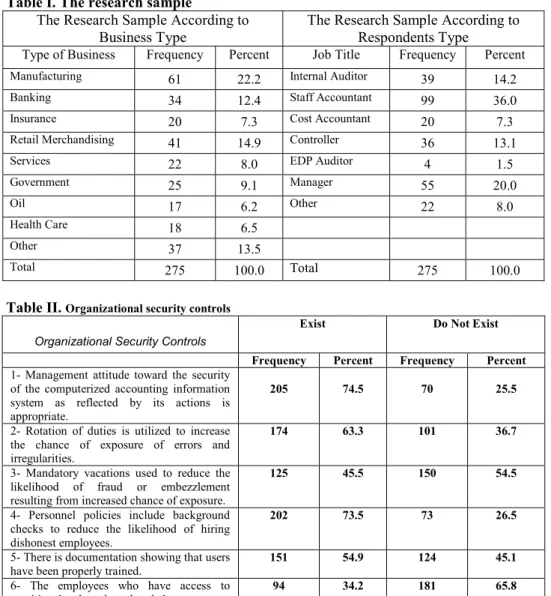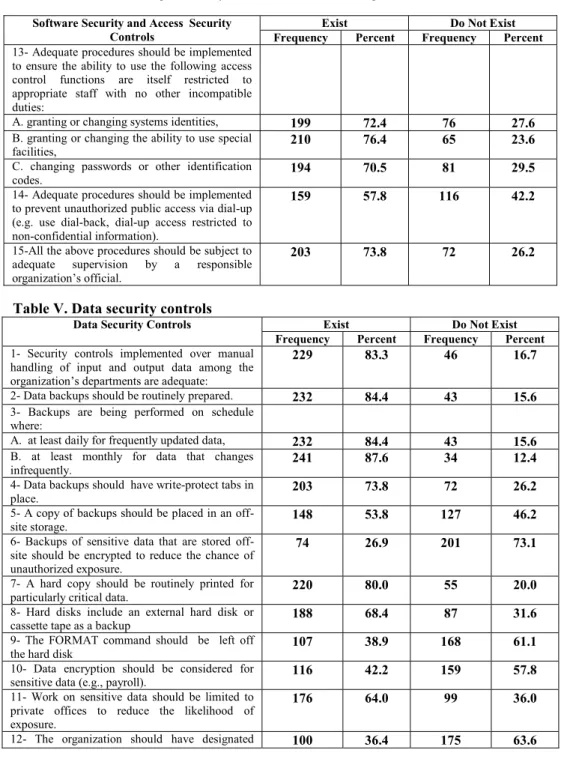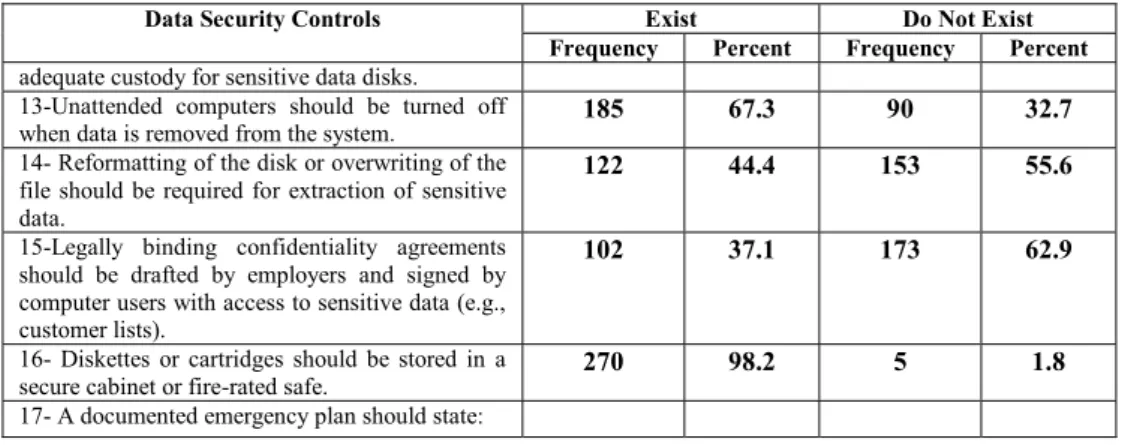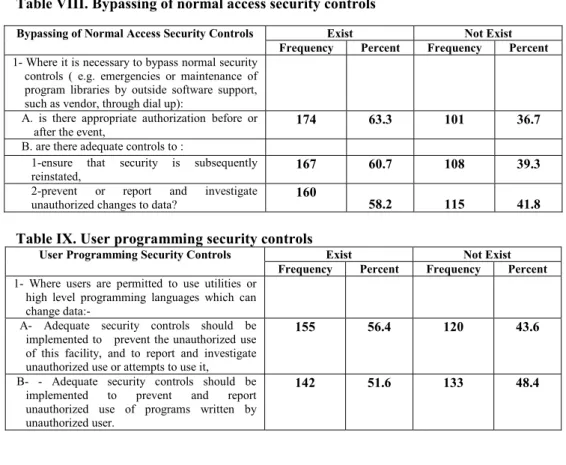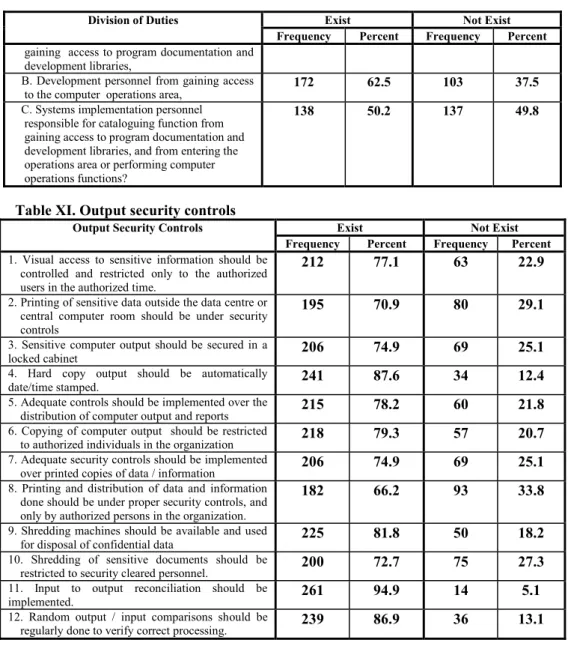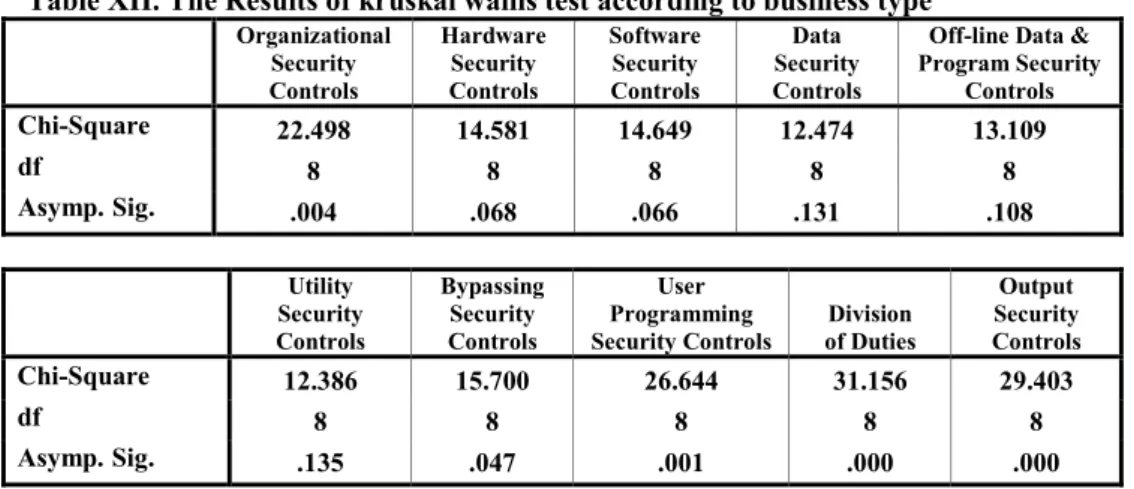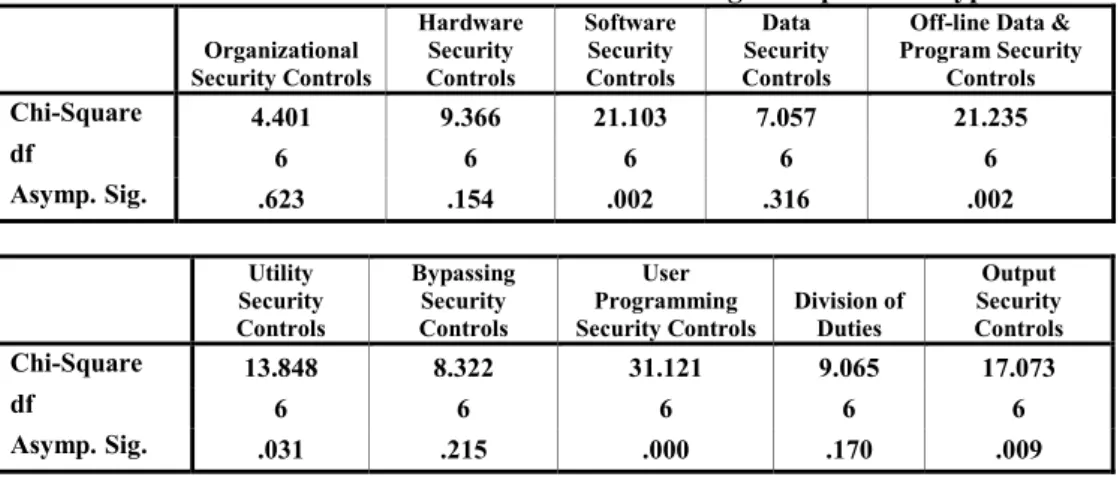The current study also aims to investigate whether there are significant differences between Saudi organizations with regard to the implemented CAIS safeguards. Many of the COBIT security controls were selected and included in the proposed checklist to be empirically tested in the Saudi business environment. Many of the safeguards were also selected and included in the proposed safeguards checklist to be empirically examined in the Saudi organizations.
Many of the security controls introduced by Qureshi and Siegel [37] are selected to be empirically tested in the Saudi environment. The study provides invaluable empirical findings regarding inadequacies of implemented CAIS security controls and introduces some suggestions for strengthening security controls in EBS. The current study developed and tested an integrated and comprehensive checklist of CAIS security controls.
H2: There are no significant differences between Saudi organizations regarding the adequacy of implemented CAIS security controls. H3: There are no significant differences between different respondent groups regarding the adequacy of implemented CAIS security controls in their organizations.
Methodology
After excluding the incomplete and invalid responses, the study ended up with 275 valid and usable questionnaires, representing a response rate of 55. This response rate is considered a relatively high response rate in this type of empirical study. A reliability test was performed on the questionnaire using the Alpha Cronbach model to explore its internal consistency based on the average inter-item correlation.
The result of the reliability test shows that the design of the questionnaire is very reliable and the collected data related to the implemented CAIS safeguards in Saudi organizations are very reliable and consistent (Alpha = 0.8735). The student test performed examines whether there are significant differences between early responses (190 questionnaires) and late responses (85 questionnaires). Student test results show no significant differences between early and late responses (at significance level p 0.05), providing evidence of a representative and unbiased selected research sample.
The data collected show that 61 of the responding organizations were manufacturing companies and 41 were retail organizations, representing 22.2 percent and 14.9 percent of the total responses, respectively (Table I). In addition, 22 respondents (8 percent) were service organizations and 17 respondents (6.2 percent) were from the oil and gas industry. As (Table I) shows, 99 respondents (36 percent) were accountants; 55 respondents (20 percent) were managers; 39 respondents (14.2 percent) were internal auditors; and 36 respondents (13.1 percent) were controllers.
Again, the respondents seem to be quite representative of the job structure in Saudi organizations. The collected data was analyzed using the Social Science Statistical Package (SPSS) version 12. Descriptive statistics (such as frequencies and percentages) of the collected data are performed to identify the main characteristics of the research variables.
In addition, a non-parametric test (the Kruskal-Wallis test) is performed to test the research hypotheses related to the existence and adequacy of implemented CAIS security controls in Saudi organizations.
Results
- Organizational security controls
- Hardware and physical access security controls
- Software and electronic access security controls
- Data security controls
- Off-line programs and data security controls
- Utility security controls
- Bypassing of normal access security controls
- User programming security controls
- Division of duties
- Output security controls
A high percentage of respondents confirmed the adequacy of implemented security controls to limit physical access to their organizations' computer terminals, to the computer room, to hardware outside the computer room (such as network switching equipment or modems) and to communication lines. (for example, cables sealed in ducts outside the hardware area to prevent them from being tapped or read by service equipment) (Table III). A high percentage of respondents (almost 65 percent) confirmed the absence of internal trip alarms within their computers. According to the statistics of the Kruskal-Wallis tests (Table XII), it appears that there are no significant differences between Saudi organizations regarding the existence and implementation of the hardware and physical access security controls at significance level p 0.05.
Again, the Kruskal-Wallis test statistics (Table XIII) show no significant differences between different respondent groups' opinions regarding the existence and implementation of hardware and physical access security controls in their organizations at p 0.05. Furthermore, the majority of respondents confirmed the adequacy of the security controls implemented in relation to granting and revoking authorized access to the system (such as user IDs or passwords, access cards), granting and withdrawing special facilities from users (e.g. eg ability to use certain utilities, hierarchical levels of clearance) and protection of security tables stored on the system to verify authenticity (password control files or communication control tables which may be one-way encrypted). The results of the Kruskal-Wallis test (Table XII) show no significant differences among Saudi organizations regarding the existence of implementing the software and electronic access security controls (at significance level p 0.05).
On the other hand, the Kruskal-Wallis test (Table XIII) shows significant differences between the viewpoints of respondent groups regarding the existence and implementation of the software and electronic access security control countermeasures in their organizations (p 0.05). The results show that the vast majority of respondents (83.3 percent) confirmed the adequacy of security controls on the manual handling of input and output data in their organization (Table V). Again, the majority of respondents confirmed that their organizations' data disks and cartridges are stored in a very strong, secure cabinet or a fire-rated safe.
A high percentage of respondents (70 percent) confirmed the separation of incompatible accounting duties and tasks in their organizations (that is, authorization, record keeping and custody). A majority of respondents (80.4 percent) agreed on the adequacy of implementing security controls to prevent computer operators, schedulers, data entry personnel, and other operational personnel from accessing program documentation and development libraries in their organizations. The majority of respondents (77.1 percent) confirmed that all sensitive data in their organization is safe and protected.
The vast majority of respondents (nearly 95 percent) confirmed that input to output reconciliation is adequately implemented in their organizations. Furthermore, 78.2 percent of respondents confirmed that the security controls implemented were adequate for printing, copying and distribution of their computer output and reports. Furthermore, it appears that there are significant differences among the respondent groups (Table XIII) regarding the existence and implementation of the output safety control countermeasures in their organizations (again at p. 0.05).
Conclusion
Investigating differences in the opinions of CAIS programmers and designers, internal auditors, external auditors, and CAIS operational staff may be potential avenues for future research. 2004a), “Threats of computerized accounting information systems: An empirical study on Saudi organizations”, Journal of Public Administration, Institute of Public Administration, Riyadh, Saudi Arabia, Vol. 2004b), "Investigating The Security Policies of Computerized Accounting Information Systems in the Banking Industry of an Emerging Economy: The Case of Egypt", The Business Review of Information Systems, USA, Summer. 2004c), “Investigating the Security Controls of CAIS in an Emerging Economy: An Empirical Study on Egyptian Banking Industry”, The Journal of Managerial Auditing, UK, Vol. 2002), “Computer Crimes: How Can You Protect Your Computerized Accounting Information System”, The Journal of American Academy of Business, Cambridge, USA, Vol.
Tang Information Technology in Saudi Arabia's Supermarket Chains", International Journal of Retail & Distribution Management, Vol. 9] Collier, Paul; Rob Dixon and Claire Marston (1991), "The Internal Auditor's Role in the Prevention and Detection of Computer Fraud", Public Money & Management, (Winter), PP. Integrated Framework (COSO, New York). 1995), "Four years after massive war spending Saudi Arabia gets its second wind," The Washing ton Report on Middle East Affairs, (September), p .48-52.
13] Dickinson (1990), Statistical Analysis in Accounting and Finance, Philip Allan, London. 1999), “Management and control of computer misuse”, Information Management &. Backhouse (2000), "Managing Information Systems Security in the New Millennium", Association for Computing Machinery, Communications of the ACM, New York, (Vol. 43, Iss. 7), PP. 1990), "Accounting Irregularities and Computer Fraud", National Public Accountant, (Vol. 1994), "Internal Checklist for Hospitality Computer Systems", Bottom Line, (Vol. Dowland (2000), "An Architecture conceptual for real-time intrusion monitoring", Information Management & Computer Security, (Vol. 8, Iss. 2), PP.65-75.
26] International Federation of Accountants (IFAC), Committee on Information Technology, (1998), International Guidelines for Information Technology: Managing Information Security, (January), New York Analyzing Saudi Arabia's Competitive Advantages Using Porter's Model, Journal of Business and Industrial Marketing, Vol. Al-Abdali Use of Third Party Logistics in Saudi Arabia Current Status and Future Prospects", International Journal of Physical Distribution & Logistics Management, Vol. 40] Solms, Rossouw Von (1996), “Information Security Management: The Second Generation”, Computer. 2000), “A conceptual basis for organizational information security awareness”, Information Management and Computer Security, Bradford, (Vol.
Wright (2002), “Information System Assurance for Enterprise Resource Planning Systems: Implementation and Unique Risk Considerations,” Journal of Information Systems, Vol.
Appendixes
15- Legally binding confidentiality agreements should be drawn up by employers and signed by computer users with access to sensitive data (eg customer lists). Off-line programs and data security controls do not exist do not exist Frequency Percentage Frequency Percentage 1- Where programs and data, including backup. Utility Security Controls Not Existed Frequency Percent Frequency Percent use or attempted use of such programs.
A review of such reports should be conducted by a responsible official to determine and investigate unauthorized access. Bypassing normal access security checks does not exist. Frequency Percentage Frequency Percentage 1- Where it is necessary to bypass normal security. B- - Appropriate security controls should be implemented to prevent and report unauthorized use of programs written by unauthorized users.
Division of Duties Exists Not Exists Frequency Percentage Frequency Percentage obtaining access to program documentation and. Printing of sensitive data outside the data center or central computer room must be under security control. Printing and distribution of data and information must take place under appropriate security control and only by authorized persons in the organization.
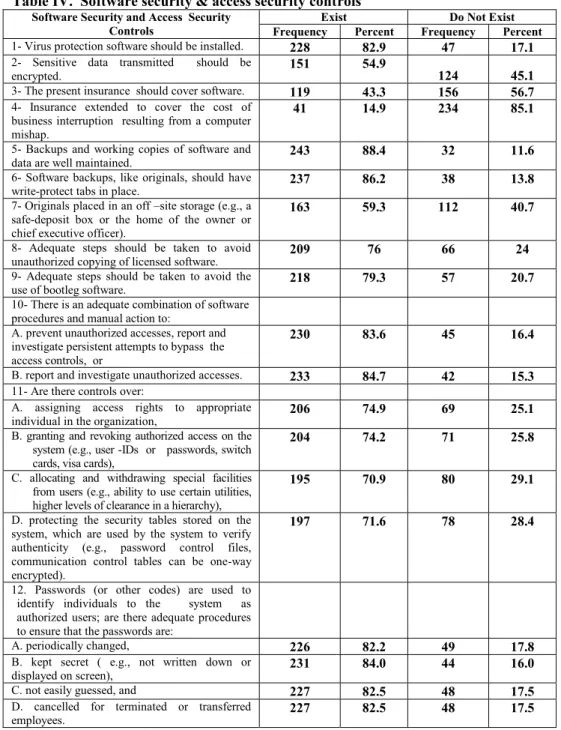
ﻦﻣﻷ ﺔﻴﺑﺎﻗﺮﻟا ﻂﺑاﻮﻀﻟا ﻢﻴﻴﻘﺗﺔﻴﻧوﺮﺘﻜﻟﻹا ﺔﻴﺒﺳﺎﺤﻤﻟا تﺎﻣﻮﻠﻌﻤﻟا ﻢﻈﻧ
ﻰﻓﺔﻳدﻮﻌﺴﻟا تﺄﺸﻨﻤﻟا
ﺔﺳاردﺔﻴﻧاﺪﻴﻣ
ﻰﺳﻮﻣ ﻮﺑأ مﻼﺴﻟا ﺪﺒﻋ ﺪﻤﺣأ ﺔﻳرادﻹا تﺎﻣﻮﻠﻌﳌا ﻢﻈﻧو ﺔﺒﺳﺎﶈا ﻢﺴﻗ
ندﺎﻌﳌاو لوﱰﺒﻠﻟ ﺪﻬﻓ ﻚﻠﳌا ﺔﻌﻣﺎﺟﺔﻳدﻮﻌﺴﻟا ﺔﻴﺑﺮﻌﻟا ﺔﻜﻠﻤﳌا ،ناﺮﻬﻈﻟا ،
ﺚﺤﺒﻟا ﺺﺨﻠﻣ
ﱃإ ﺚﺤﺒﻟا اﺬﻫ فﺪﻬﻳﺔﻘﺒﻄﳌا ﺔﻴﺑﺎﻗﺮﻟا ﻂﺑاﻮﻀﻟا ﺔﻳﺎﻔﻛ ىﺪﻣو دﻮﺟو ﻢﻴﻴﻘﺗ
ﺔﻳﺎﻤﳊ
ﺔﻳدﻮﻌﺴﻟا تﺄﺸﻨﳌا ﰲ ﺔﻴﻧوﱰﻜﻟﻹا ﺔﻴﺒﺳﺎﶈا تﺎﻣﻮﻠﻌﳌا ﻢﻈﻧ ﻦﻣأ ﺔﺳارد ﻞﻤﻌﺑ ﺚﺣﺎﺒﻟا مﺎﻗ ﺪﻘﻟو
ﺔﻴﻧاﺪﻴﻣ
ﻰﻠﻋﳌا
ﻊﻳزﻮﺗ ﰎ ﺪﻘﻟو
ﺔﺋﺎﻤﺴﲬ دﺪﻋءﺎﺼﻘﺘﺳإ ﺔﻤﺋﺎﻗ
ﻦﻣ ﺔﻴﺋاﻮﺸﻋ ﺔﻨﻴﻋ ﻰﻠﻋﺔﻳدﻮﻌﺴﻟا تﺄﺸﻨﳌا
دﺪﻋ ﻞﻴﻠﲢو ﻊﻴﻤﲡ ﰎ ﺚﻴﺣ ،
ﲔﻌﺒﺳو ﺲﲬو ﲔﺘﺋﺎﻣءﺎﺼﻘﺘﺳإ ﺔﻤﺋﺎﻗ
ﻞﻴﻠﺤﺘﻟا ضاﺮﻏﻷ ﺔﳊﺎﺻو ﺔﻠﻤﺘﻜﻣأ ﺪﻘﻟو
تﺮﻬﻇﺘﻧ
ﺔﻳﺎﻔﻛ مﺪﻋو رﻮﺼﻘﻟا ﻰﺣاﻮﻧ ﻦﻣ ًادﺪﻋﳌا ﻚﻠﺗ ﰱ ﺔﻘﺒﻄﳌا ﺔﻴﺑﺎﻗﺮﻟا ﻂﺑاﻮﻀﻟا
ﺄﺸﻨت
ﺔﻴﻧوﱰﻜﻟﻹا ﺔﻴﺒﺳﺎﶈا تﺎﻣﻮﻠﻌﳌا ﻢﻈﻧﺮﻃﺎﺨﳌا ﺪﺿ
ﳌاﺘﺨ
ﺰﻳﺰﻌﺗو ﻢﻴﻋﺪﺗ ﰱ ﻢﻬﺴﺗ نأ ﻦﻜﳝ ﱴﻟا تﺎﻴﺻﻮﺘﻟاو تﺎﺣﱰﻘﳌا ﻦﻣ ًادﺪﻋ ﺔﺳارﺪﻟاﺔﻴﺑﺎﻗﺮﻟا ﻂﺑاﻮﻀﻟا
ﺔﺻﺎﳋا
ﺑﻢﻈﻧ ﻦﻣﺄ
ﻩﺬﻫ ﺞﺋﺎﺘﻧ نﺈﻓ ﺔﻴﻠﻤﻌﻟا ﺔﻴﺣﺎﻨﻟا ﻦﻣو
ﻰﻣﺪﺨﺘﺴﻣو ﲔﻴﻨﻬﳌا ﻦﻣ ﻢﻫﲑﻏو ﲔﻴﺟﺮﳋاو ﲔﻴﻠﺧاﺪﻟا ﲔﻌﺟاﺮﳌاو تﺄﺸﻨﳌا ىﺮﻳﺪﻣ ﻦﻜﲤ فﻮﺳ ﺔﺳارﺪﻟا ﺔﻴﻧوﱰﻜﻟﻹا ﺔﻴﺒﺳﺎﶈا تﺎﻣﻮﻠﻌﳌا ﻢﻈﻧ
ﺳﺎﶈا تﺎﻣﻮﻠﻌﳌا ﰲ ﺔﻴﻧوﱰﻜﻟﻹا ﺔﻴﺒ
ﺔﻳدﻮﻌﺴﻟا تﺄﺸﻨﳌا ﺔﺒﺳﺎﻨﳌا ﺔﻴﺤﻴﺤﺼﺘﻟا تارﺮﻘﻟا ذﺎﲣإ ﺔﻴﻧﺎﻜﻣإ ﰒ ﻦﻣو ،ﺎ رﻮﺼﻘﻟا ﻰﺣاﻮﻧ ﻰﻠﻋ فﺮﻌﺘﻟاو
ﺰﻳﺰﻌﺗو ،ﺔﻔﻠﺘﺨﳌا رﻮﺼﻘﻟا ﻪﺟوأ ﰱﻼﺘﻟﺔﻴﺑﺎﻗﺮﻟا ﻂﺑاﻮﻀﻟا
ﻦﻣ ﻰﻠﺜﳌا ةدﺎﻔﺘﺳﻹا ﻖﻘﳛ ﺎﲟ ﻢﻈﻨﻟا ﻚﻠﺘﻟ ﺔﻴﻨﻣﻷا
تﺎﻣﻮﻠﻌﳌا ﺎﻴﺟﻮﻟﻮﻨﻜﺗﺔﻳدﻮﻌﺴﻟا تﺄﺸﻨﳌا ﰲ
